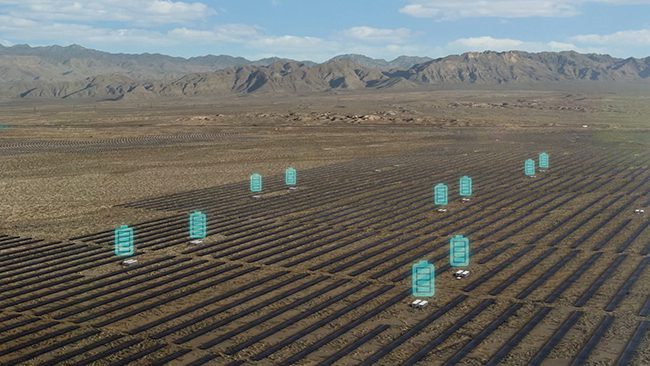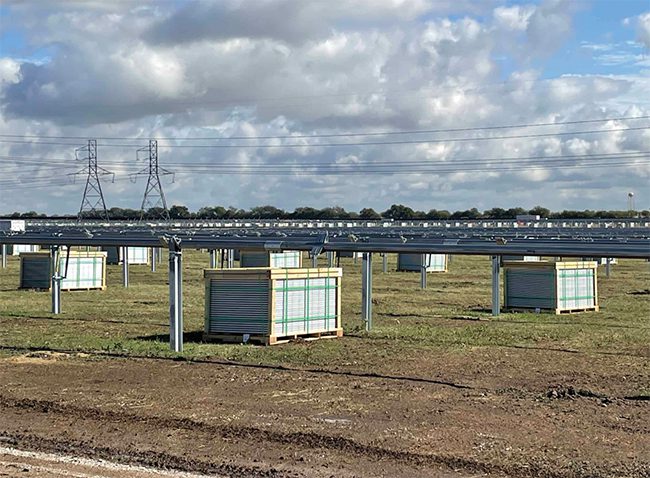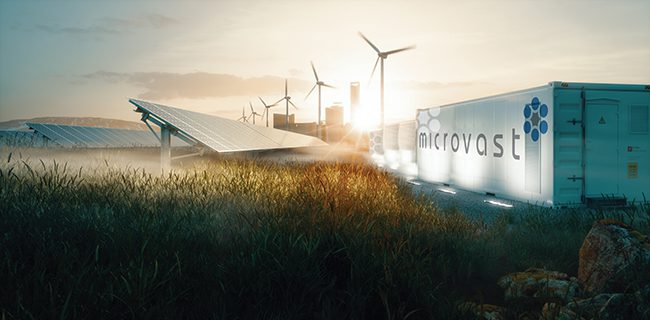New Rules, Incentives Shaping Solar-Plus-Storage Market

An evolving regulatory environment, expanded tax credits, and moves for more reliability and resilience in the power space are impacting the growth of solar-plus-storage installations.
Several state utility commissions in recent years have reduced the export rate for net energy metering (NEM), meaning consumers utilizing solar power are seeing less value for the solar energy they would return to the power grid. These measures, such as one recently passed in California and taking effect in April, have sparked plenty of debate in the solar power community. Detractors say it makes residential solar less attractive, taking away a financial incentive for installation. Proponents say it incentivizes the use of energy storage attached to solar power, and over time will prove advantageous for more solar power adoption.
Critics of plans to reduce export rates say such moves benefit utilities at the expense of homeowners, and are likely to slow growth in residential solar by making rooftop arrays more expensive. Others see the measures as a way to jump-start the nascent residential solar-plus-storage market, providing opportunities for solar installers to pair systems with batteries, reducing costs over time. Most everyone agrees, though, that tax credits and other features in the Inflation Reduction Act (IRA) signed by President Biden last year provide important support for both the solar and storage industries.
Supporters of energy storage point to benefits already being recognized as solar developers and utilities add batteries to large, utility-scale solar arrays, to provide more resilience and help balance the grid. The next step, according to many in the industry, is growing residential storage, which will provide other benefits including supporting growth in electric vehicle (EV) adoption.
Germany provides an example. Changes to NEM rules there a decade ago set off consistent growth in solar paired with storage, which recently has experienced even faster growth. EUPD Research, a Germany-based international data-based market research and consulting group, in a recent report said about 220,000 new residential storage systems were connected to rooftop solar in Germany in 2022.
Consumers around the world are seeking residential solar solutions that provide energy independence and security in the face of rising electricity prices and massive grid disruptions driven by extreme weather," said Raghu Belur, co-founder and Chief Products Officer for Enphase Energy, a California-based energy technology company. In fact, residential solar deployments are forecast to grow over 35% in the next four years while residential battery storage is expected to grow over three-fold by 2026, according to recent reports by Wood Mackenzie and SEIA [the Solar Energy Industries Association], and ESA [the Energy Storage Association], respectively."
Belur told POWER, Solar-plus-battery storage technology is well-positioned to adapt to an increasingly electrified future by seamlessly integrating with EVs, heat pumps, and other connected home appliances, making it easier than ever for consumers to manage their household energy bills and take control of their own energy future."
The trend of rising energy costs and a need for greater energy resilience in the face of increasingly frequent grid outages and emergency shut-offs has driven surging interest in behind-the-meter PV-plus-storage systems, especially in Europe," said Levent Gun, CEO of Ampt, a solar and storage company working to lower costs and increase optimization of PV systems. Among the numerous factors driving the growth of solar-plus-storage in the U.S. and around the world are improving economics, policy support, and the simple fact that a renewables-dominated grid requires abundant storage to remain stabilized and resilient."
Integrating Renewable EnergyOther experts who spoke with POWER agreed with Gun that upgrades to power delivery infrastructure need to include energy storage, particularly when it comes to integrating solar and other renewable energy to the grid.
Storage is absolutely critical to the advancement and modernization of the grid. Renewable projects simply cannot support the grid in a meaningful way without storage," said Julie Steury, vice president of Programs & Customer Ops with Stem, a California-based group using artificial intelligence to help manage energy assets. Increased energy demands, unstable energy sources and costs, and unreliable access from increasing weather incidents happen outside of solar generation. Intelligent storage and renewable asset management with advanced software solutions will enable businesses and utilities to effectively capture that clean energy, store it properly, and know when to discharge that energy for the best results."
Mary Powell, CEO of Sunrun, a California-based provider of solar and storage products, told POWER: The overall duration of power interruptions in the U.S. has more than doubled since 2015, and with natural disasters also on the rise, blackouts are inevitable. This leaves utilities challenged with adapting current energy systems to these worsening conditions. In 2023, we will see a growing momentum across the country to incorporate home solar and battery capacity as regulators look to provide greater resilience to the electric grid."
As utilities continue to get more comfortable with energy storage on their systems, we are seeing an expansion of acceptable applications," said Mike Toomey, director of storage development at Redeux Energy, a clean energy project developer. Storage is now being considered an option to mitigate transmission and distribution upgrades. As that trend evolves, we may even see scenarios where solar is co-located with storage transmission assets to avoid the need to charge from the grid under more extreme constraint scenarios."
Marija Vujacic, PhD, product manager for Battery Energy Storage Systems with Hitachi Energy, told POWER that storage adds a fundamental value in balancing the variability of solar generation while at the same time enabling higher consumption of a self-generated renewable power. It enables bidirectional active power exchange with the grid, which enables storage to provide a wide range of applications that cannot be provided by solar-only systems such as stabilizing and operating isolated renewable-driven power systems."
Utility-Scale ProjectsRecent utility-scale solar-plus-storage projects include the Darien Solar Energy Center in Wisconsin. The state's Public Service Commission recently approved Madison Gas and Electric Co.'s (MGE's) request to buy solar energy and battery storage capacity from the $478 million facility, which includes 250 MW of solar and 75 MW of battery storage. Madison Gas will own 25 MW of solar energy and 7.5 MW of battery storage from the Invenergy-developed project.
The Darien Solar Energy Center is another important step in our ongoing transition to cleaner energy sources, reducing carbon at least 80% by the end of this decade and achieving net-zero carbon electricity by 2050," said Jeff Keebler, chairman, president, and CEO of MGE. The rest of Darien's solar and storage is expected to be owned by WEC Energy Group subsidiaries We Energies and Wisconsin Public Service. The Darien site is expected to enter commercial operation by year-end 2024.
 |
1. This is a rendering of the 690-MW Gemini solar and storage project being built near Las Vegas, Nevada. Courtesy: IHI Terrasun Solutions |
The pace of storage integration into solar projects is accelerating as utilities and independent system operators (ISOs) realize the need and benefit of having co-location of solar and storage facilities," said Ray Saka, vice president of Sales and Service for IHI Terrasun Solutions, the system integrator and service provider for the 690-MW Gemini solar and storage project (Figure 1) being built near Las Vegas, Nevada. We've also noticed an uptick in the adoption of DC-coupled solar plus storage versus its AC-coupled alternative or standalone projects." (Editor's note: Get more insight from IHI Terrasun in this POWER Interview with company president Jamal Burki.)
Saka told POWER, though, that with the IRA incentive for standalone storage systems, we may see more development of standalone systems that can now claim the tax credit, along with potential for more advantageous siting that is not tied to the expanse needed for solar projects."
On a smaller scale, microgrid developers increasingly are including storage, along with solar and other technologies, in installations designed for off-grid and backup power sites, especially as power reliability becomes more of an issue.
As a company mostly focusing on off-grid and hybrid applications, we are seeing much more of a demand in the resilience and emergency response space," said Colin Touhey, CEO of Pvilion, a New York-based solar equipment developer and manufacturer. The resiliency world is a very big market. There is a strong desire to be completely independent from the grid, or have the ability to disconnect and run independent microgrids."
Touhey told POWER his company is seeing demand for storage in grid-tied applications in more than 50% of our new projects. Four or five years ago, that demand was about 10%. The solar energy produced can be fed into the grid as needed to maximize revenues. In the off-grid applications that Pvilion builds [which include communications; command centers; heating, ventilation, and air conditioning; and radar systems], this is critical, since the demand varies throughout the day. The energy storage system acts as a buffer between the supply of power [solar] and the demand [load]."
PPAs Support ProjectsPower purchase agreements (PPAs) continue to drive solar-plus-storage deployments. National Grid Renewables recently announced the start of commercial operation at its Noble Solar and Storage Project (Figure 2) in Denton County, Texas. The installation is a 275-MW solar and 125-MWh energy storage facility, which Blake Nixon, president of National Grid Renewables, said is the group's first utility-scale energy storage project, as well as our largest solar energy project to date."
 |
2. The Noble Solar and Storage installation in Texas includes 275 MW of solar power capacity along with 125 MWh of energy storage. Courtesy: National Grid Renewables |
The Home Depot and NRG Energy have each executed individual 100-MW solar PPAs with the Noble project, and The Hershey Company has contracted on a 50-MW solar PPA. The project utilizes Fluence Energy's sixth-generation Gridstack product for energy storage.
Steury noted the importance of PPAs to project deployments. Total commercial solar installations are expected to double again over the next three years with nearly 27 GW of off-site projects with corporate off-takers scheduled to come online by 2025. We've already seen companies across every industry establishing ESG [environmental, social, and governance], and net-zero goals, and showing clear progress with solar-plus-storage pilots. Now, with [the] IRA unlocking critical incentives and removing some of the historical risks, we'll see broader adoption of solar-plus-storage assets beyond the bigger brands and early adopters."
With the extension of tax credits for solar, we expect to see more deployments in the distributed space," said Toomey. As market rates dictate, solar will create a mini duck curve' for the individual system owner, adding justification to add storage to mitigate the demand charges that are now a shorter, more predictable period in the day."
Toomey told POWER, The largest savings by co-locating storage with a solar farm comes in the form of shared development and equipment costs. A standalone storage project would need to go through separate permitting, interconnection filings, and in many cases a costly transformer. By incorporating with solar, the cost of storage is reduced to land, which is largely de minimis compared to the land requirements of solar, and the equipment costs up to and including medium voltage."
Policy Supports U.S. Manufacturing, InstallationsGrowth in solar-plus-storage also is being driven by incentives in the IRA, which support U.S. manufacturing of solar and storage equipment, along with new projects.
The proliferation of new solar-plus projects in the interconnection queues due to favorable economics-solar-plus-storage is a cost-effective solution based on the cost of materials-and the IRA act is encouraging new solar projects through the next two or three decades," said Kevin Kohlstedt, director of Business Development at Energy Shares, a group that provides investors direct access to U.S. renewable energy development projects. Solar panel manufacturing and battery manufacturing is coming back to the U.S. Thanks to the IRA, the production tax credits plus the huge demand from U.S. projects is driving U.S. manufacturing."
 3. This is a conceptual rendering of a Microvast smart grid renewable energy system. Courtesy: Microvast
3. This is a conceptual rendering of a Microvast smart grid renewable energy system. Courtesy: MicrovastMicrovast, a Texas-headquartered group with operations in the UK, Germany, and China, along with the U.S., in December said it would supply its BESS ME-4300 container solution (Figure 3) for a 1.2-GWh battery energy storage project co-located with a solar installation. The exact location was not disclosed. The company said its battery cells manufactured at its factory in Clarksville, Tennessee, are expected to qualify for incentives under the IRA. The company also in late December announced the opening of a Technology and Testing Center in Timnath, Colorado, near Fort Collins, as part of its expansion.
The customer response to our recently launched ME-4300 solution has been extremely promising and we are excited to be selected as a key supplier for one of the largest energy storage projects in the United States," said Zach Ward, president of Microvast Energy. This project will help position Microvast as a leader in the utility-scale energy storage market while reducing carbon emissions and assisting the local utility in meeting its growing electricity needs."
DSD Renewables (DSD) and Black Bear Energy late last year announced they had begun installation of onsite rooftop solar systems, totaling 554 kW, at two Signature Center office buildings in Pleasanton, California. The systems will include energy storage.
It has been great to work with trusted partners and see the teams come together on the first two rooftop solar systems that exemplify a commitment towards a cleaner future," said Jason Chiang, senior director of Commercial Origination at DSD. With long-term savings in mind, the solar systems paired with battery storage will help stabilize energy costs over the next 20 years." The projects will be built and owned by DSD Renewables, and facilitated by Black Bear Energy. They are the first in a series of four office campuses that will include rooftop solar, carport solar, and energy storage. The projects when complete will total about 3 MW of solar and 3.8 MWh of battery storage.
Maxine Ghavi, senior vice president, Head of Grid Edge Solutions for Hitachi Energy, said power structures based on demand charges and time-of-use rates will help drive the solar-plus-storage market. Ghavi in a recent POWER Interview noted, Solar-plus-storage has been recognized as one of the key solutions towards ensuring more affordable, secure, and sustainable energy."
-Darrell Proctor is a senior associate editor for POWER (@POWERmagazine).
The post New Rules, Incentives Shaping Solar-Plus-Storage Market appeared first on POWER Magazine.